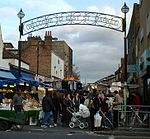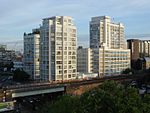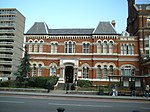Walworth
Areas of LondonDistricts of the London Borough of SouthwarkUse British English from September 2015

Walworth () is a district of south London, England, within the London Borough of Southwark. It adjoins Camberwell to the south and Elephant and Castle to the north, and is 1.9 miles (3.1 km) south-east of Charing Cross. Major streets in Walworth include the Old Kent Road, New Kent Road and Walworth Road.
Excerpt from the Wikipedia article Walworth (License: CC BY-SA 3.0, Authors, Images).Walworth
Browning Estate, London Walworth (London Borough of Southwark)
Geographical coordinates (GPS) Address Nearby Places Show on map
Geographical coordinates (GPS)
| Latitude | Longitude |
|---|---|
| N 51.4898 ° | E -0.0905 ° |
Address
Browning Estate
Browning Estate
SE17 1EE London, Walworth (London Borough of Southwark)
England, United Kingdom
Open on Google Maps






